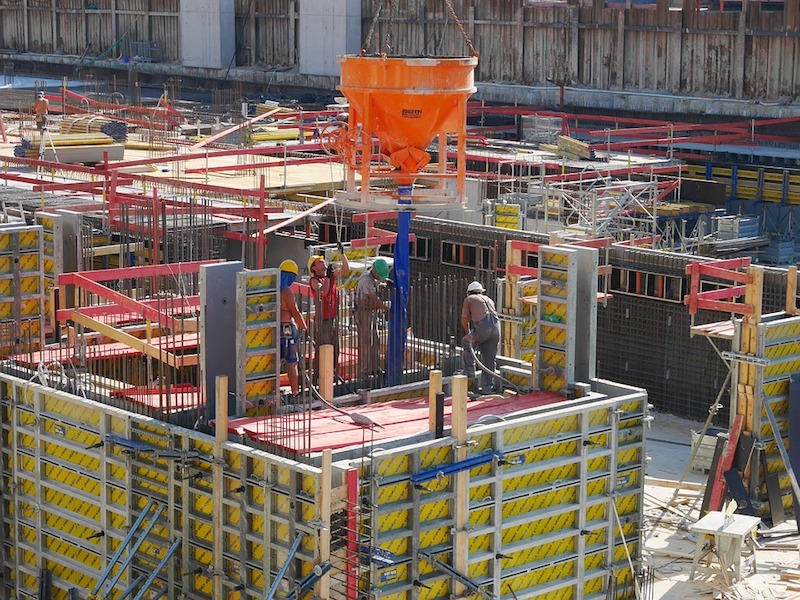Strong construction momentum will easily carry through the first half of 2019, despite project margins facing pressure from all sides. JLL’s Construction Outlook finds robust U.S. economic fundamentals will drive further growth of the sector, which in 2018 recorded a 5.1% increase in total construction value and a 4.5% increase in employment.
Potential risks to the construction sector such as trade war escalation, deteriorating macroeconomic conditions and the worsening labor shortage, are largely balanced by potential boosts that include a large-scale federal infrastructure package, relief from tariffs and the continuation of 3.5% annual GDP growth.
“All forward indicators for construction are still flashing green,” said Todd Burns, President, Project and Development Services, JLL Americas. “However, a year with growth equal to that of 2018 would be considered a success, given concerns of a broader economic slowdown.”
Rising construction costs will sideline select projects
Total building costs, which includes labor, materials and equipment, grew by 3.4% in 2018, outpacing the U.S. inflation rate of 1.9%. The widening spread between cost growth and inflation is pushing borderline projects past the threshold of profitability. Building costs will continue to increase in 2019 but at a slower rate than 2018. This reflects an expected cooldown in material pricing but the surging cost of labor.
Growth in total construction employment has hovered between 3 and 6% over the past six years – a far cry from what’s required for labor supply to catch up with demand. With a tight national employment market, the situation is unlikely to improve anytime soon. Construction wage growth in 2019 will top the 3.4% increase seen last year.
Trade policy a powerful “swing” force
With a direct impact on commodity prices, tariffs represent a uniquely immediate threat to an industry that typically moves slowly. Given the well-established political willingness to impose tariffs and the widening trade deficit with China, a continuation of tariffs in 2019 is expected.
The biggest chance for relief from tariffs are international trade deals that would lift tariffs in exchange for other trade or economic concessions. Such a deal could represent a dramatic positive for construction and is a potential bright spot for the industry.
Construction tech in growth mode, presents opportunity for labor shortage relief
The buzz around construction technology has long eclipsed actual adoption in the industry. The past year, however, saw meaningful gains fueled by large general contracting firms racing to improve productivity and remain competitive. High levels of tech adoption will spread to smaller firms, and elements of construction tech will become the standard across the industry in 2019. Amid intense labor pressures, contractors’ most common reason for making technology investments is to increase labor productivity.
Modular construction is poised to have the biggest long-term impact on the industry. Proponents of the technology envision a future full of dedicated warehouses churning out modular components – from exterior wall segments to entire apartment units – for most new construction.
“Adopting modular construction is not always as simple as it sounds,” said Henry D’Esposito, Senior Research Analyst, Project and Development Services, JLL. “There is often a prolonged period during which the benefits are not fully realized, as firms take time to adjust to the new system. Despite some of the initial challenges, there has been no hesitation among contractors about whether modular will continue to grow.”
Growth of modular construction in 2019 will be centered around increased use by select sectors, including hospitality and healthcare, and an increase in use for one or two select elements within a broader array of projects.
Related Stories
Market Data | Oct 19, 2021
Demand for design services continues to increase
The Architecture Billings Index (ABI) score for September was 56.6.
Market Data | Oct 14, 2021
Climate-related risk could be a major headwind for real estate investment
A new trends report from PwC and ULI picks Nashville as the top metro for CRE prospects.
Market Data | Oct 14, 2021
Prices for construction materials continue to outstrip bid prices over 12 months
Construction officials renew push for immediate removal of tariffs on key construction materials.
Market Data | Oct 11, 2021
No decline in construction costs in sight
Construction cost gains are occurring at a time when nonresidential construction spending was down by 9.5 percent for the 12 months through July 2021.
Market Data | Oct 11, 2021
Nonresidential construction sector posts first job gain since March
Has yet to hit pre-pandemic levels amid supply chain disruptions and delays.
Market Data | Oct 4, 2021
Construction spending stalls between July and August
A decrease in nonresidential projects negates ongoing growth in residential work.
Market Data | Oct 1, 2021
Nonresidential construction spending dips in August
Spending declined on a monthly basis in 10 of the 16 nonresidential subcategories.
Market Data | Sep 29, 2021
One-third of metro areas lost construction jobs between August 2020 and 2021
Lawrence-Methuen Town-Salem, Mass. and San Diego-Carlsbad, Calif. top lists of metros with year-over-year employment increases.
Market Data | Sep 28, 2021
Design-Build projects should continue to take bigger shares of construction spending pie over next five years
FMI’s new study finds collaboration and creativity are major reasons why owners and AEC firms prefer this delivery method.
Market Data | Sep 22, 2021
Architecture billings continue to increase
The ABI score for August was 55.6, up from July’s score of 54.6.

















